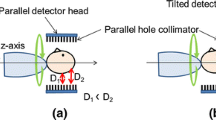Abstract
Objectives
The aim of the study was to develop a new SPECT system that makes it possible to acquire projection data stationary using a triple-head gamma camera system.
Methods
We evaluated several data acquisition geometry with multi-pinhole collimators attached to a triple-head gamma camera system. The number of pinholes for each camera was three to twelve, and we located these holes on collimator plates adequately. These collimator holes were tilted by predefined angles to efficiently cover the field of view of the data acquisition system. Acquired data were reconstructed with the OS-EM method. In the simulations, we used a three-dimensional point source phantom, brain phantom, and myocardial phantom. Attenuation correction was conducted with the x-ray CT image of the corresponding slice.
Results
Reconstructed images of the point source phantom showed that the spatial resolution could be improved with the small number of pinholes. On the other hand, reconstructed images of the brain phantom showed that the large number of pinholes yielded images with less artifact. The results of the simulations with the myocardial phantom showed that more than eight pinholes could yield an accurate distribution of activity when the source was distributed only in the myocardium.
Conclusions
The results of the simulations confirmed that more than eight pinholes for each detector were required to reconstruct an artifact free image in the triple-head SPECT system for imaging of brain and myocardium.











Similar content being viewed by others
References
Ogawa K. Image distortion and correction in single photon emission CT. Ann Nucl Med. 2004;18:171–85.
Cherry SR, Sorenson JA, Phelps ME. Physics in nuclear medicine. 3rd ed. Philadelphia: Saunders/Elsevier Science; 2003.
Ben-Haim S, Kacperski K, Hain S, Van Gramberg D, Hutton BF, Erlandsson K, Sharir T, Nathaniel Roth N, Waddington WA, Berman DS, Ell PJ. Simultaneous dual-radionuclide myocardial perfusion imaging with a solid-state dedicated cardiac camera. Eur J Nucl Med Mol Imag. 2010;37:1710–21.
Bocher M, Blevis IM, Tsukerman L, Yigal Shrem Y, Kovalski G, Volokh L. A fast cardiac gamma camera with dynamic SPECT capabilities: design, system validation and future potential. Eur J Nucl Med Mol Imag. 2010;37:1887–902.
Schramm NU, Ebel G, Engeland U, Schurrat T, Behe M, Behr TM. High-resolution SPECT using multipinhole collimation. IEEE Trans Nucl Sci. 2003;50:315–20.
Beekman FJ, van der Have F, Vastenhouw B, van der Linden AJ, van Rijk PP, Burbach JP, et al. U-SPECT-I: a novel system for submillimeter-resolution tomography with radiolabeled molecules in mice. J Nucl Med. 2005;46:1194–200.
Eisen Y, Shor A, Mardor I. CdTe and CdZnTe gamma ray detectors for medical and industrial imaging systems. Nucl Instrum Method A. 1999;428:158–70.
Ogawa K, Muraishi M. Feasibility study on an ultra-high resolution SPECT with CdTe detectors. IEEE Trans Nucl Sci. 2010;57:17–24.
Ogawa K, Ohmura N, Iida H, Nakamura K, Nakahara T, Kubo A. Development of an ultra-high resolution SPECT system with a CdTe semiconductor detector. Ann Nucl Med. 2009;23:763–70.
Goorden MC, Renttmeester MCM, Beekman FJ. Theoretical analysis of full-ring multi-pinhole brain SPECT. Phys Med Biol. 2009;54:6593–610.
Hsieh HH, Lin KJ, Hsu CH, Hsiao IT. Performance evaluation on reconstructions in a stationary multi-pinhole SPECT. IEEE Conf Rec Nucl Sci Med Imag. 2009; 3777–80.
Funk T, Kirch DL, Koss JE, Botvinick E, Hasegawa BH. A novel approach to multipinhole SPECT for myocardial perfusion imaging. J Nucl Med. 2006;47:595–602.
Mahmood S, Erlandsson K, Cullum I, Hutton B. Experimental results from a prototype slit-slant collimator with mixed multiplexed and non-multiplexed data. Phys Med Biol. 2013;56:4311–31.
Bowen JD, Huang Q, Ellin JR, Lee TC, Shrestha U, Gullberg GT, Seo Y. Design and performance evaluation of a 20-aperture multipinhole collimator for myocardial perfusion imaging applications. Phys Med Biol. 2013;58:7209–26.
van Audenhaege K, Vandenberghe S, Deprez K, Vandeghinste B, van Holen R. Design and simulation of full-ring multi-lofthole collimator for brain SPECT. Phys Med Biol. 2013;58:6317–36.
Andreyev A, Defrise M, Vanhove C. Pinhole SPECT reconstruction using blobs and resolution recovery. IEEE Trans Nucl Sci. 2006;53:2719–28.
Tsui BMW, Terry JA, Gullberg GT. Evaluation of cardiac cone-beam single photon emission computed tomography using performance experiments and receiver operating characteristic analysis. Invest Radiol. 1993;28:1101–12.
Author information
Authors and Affiliations
Corresponding author
Rights and permissions
About this article
Cite this article
Ogawa, K., Ichimura, Y. Simulation study on a stationary data acquisition SPECT system with multi-pinhole collimators attached to a triple-head gamma camera system. Ann Nucl Med 28, 716–724 (2014). https://doi.org/10.1007/s12149-014-0865-2
Received:
Accepted:
Published:
Issue Date:
DOI: https://doi.org/10.1007/s12149-014-0865-2




